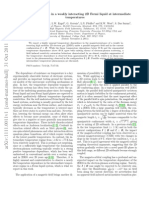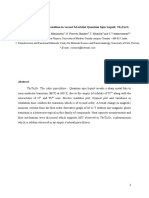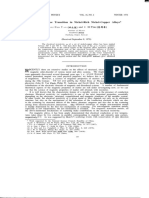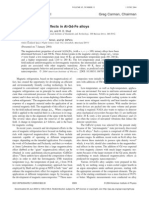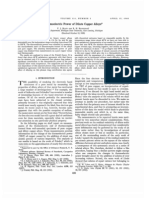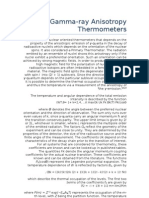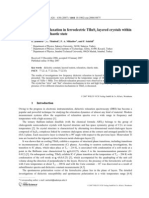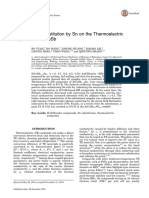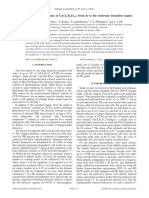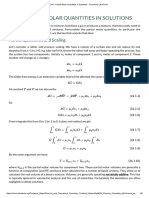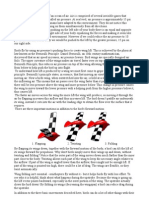0 ratings0% found this document useful (0 votes)
39 viewsParamagnetic Anisotropy, Low Temperature Magnetization, and Electronic Structure of Iron (II) Phthalocyanine
Paramagnetic Anisotropy, Low Temperature Magnetization, and Electronic Structure of Iron (II) Phthalocyanine
Uploaded by
Riccardo Constantine BrooksIron (II) phthalocyanine is an unusual example in which a large magnetic anisotropy arises entirely from the zero-field splitting. A change of about 70deg of the "setting angle" between 290 and 90 0 K is observed in this crystal when measured with b axis vertical.
Copyright:
Attribution Non-Commercial (BY-NC)
Available Formats
Download as PDF, TXT or read online from Scribd
Paramagnetic Anisotropy, Low Temperature Magnetization, and Electronic Structure of Iron (II) Phthalocyanine
Paramagnetic Anisotropy, Low Temperature Magnetization, and Electronic Structure of Iron (II) Phthalocyanine
Uploaded by
Riccardo Constantine Brooks0 ratings0% found this document useful (0 votes)
39 views6 pagesIron (II) phthalocyanine is an unusual example in which a large magnetic anisotropy arises entirely from the zero-field splitting. A change of about 70deg of the "setting angle" between 290 and 90 0 K is observed in this crystal when measured with b axis vertical.
Original Title
JChemPhys_53_1643
Copyright
© Attribution Non-Commercial (BY-NC)
Available Formats
PDF, TXT or read online from Scribd
Share this document
Did you find this document useful?
Is this content inappropriate?
Iron (II) phthalocyanine is an unusual example in which a large magnetic anisotropy arises entirely from the zero-field splitting. A change of about 70deg of the "setting angle" between 290 and 90 0 K is observed in this crystal when measured with b axis vertical.
Copyright:
Attribution Non-Commercial (BY-NC)
Available Formats
Download as PDF, TXT or read online from Scribd
Download as pdf or txt
0 ratings0% found this document useful (0 votes)
39 views6 pagesParamagnetic Anisotropy, Low Temperature Magnetization, and Electronic Structure of Iron (II) Phthalocyanine
Paramagnetic Anisotropy, Low Temperature Magnetization, and Electronic Structure of Iron (II) Phthalocyanine
Uploaded by
Riccardo Constantine BrooksIron (II) phthalocyanine is an unusual example in which a large magnetic anisotropy arises entirely from the zero-field splitting. A change of about 70deg of the "setting angle" between 290 and 90 0 K is observed in this crystal when measured with b axis vertical.
Copyright:
Attribution Non-Commercial (BY-NC)
Available Formats
Download as PDF, TXT or read online from Scribd
Download as pdf or txt
You are on page 1of 6
THE JOURNAL UF CHEMICAL PHYSICS VOLUME 53, NUMBER 5 1 SEPTEMBER 1970
Paramagnetic Anisotropy, Low Temperature Magnetization, and Electronic Structure of
Iron(II) Phthalocyanine
C. G. BARRACLOUGH, R. L. MARTIN,* AND S. MITRA
Department of Inorganic Chemistry, University of Melbourne, Parkville, Victoria, Australia 3052
AND
R. C. SHERWOOD
Bell Telephone Laboratories, Murray Hill, New Jersey 07974
(Received 9 February 1970)
Magnetic anisotropy, magnetization, and average magnetic susceptibility have been measured for iron
(II) phthalocyanine. The anisotropy was measured from the room temperature to about 90
0
K, the average
susceptibility from 296 to 1.57K, and the magnetization was measured at 1.57K for field strengths between
1100 and 15000 Oe. The results are interpreted in terms of a 3B'g ground state with a zero-field splitting
parameter D=64 em-I, and gu=g.l=2.74. Iron (II) phthalocyanine is an unusual example in which a
large magnetic anisotropy arises entirely from the zero-field splitting. The danger inherent in the existing
method of evaluation of ligand-field parameters from the average magnetic susceptibility data has been
highlighted, and the advantages of magnetic anisotropy studies in deducing the ligand-field parameters
and the electronic structures are discussed. A change of about 70 of the "setting angle" between 290 and
90
0
K is observed in this crystal when measured with b axis vertical. It is shown that this change is not
indicative of a change in the ligand-field parameters with temperature, as generally assumed previously,
but depends on the temperature dependence of the ratio of principal susceptibilities.
I. INTRODUCTION
Iron (II) phthalocyanine (henceforth abbreviated
to FePc) provides one of the few examples in which
the iron atom is in an almost perfect square planar
environment.
1
The molecular structure is shown in
Fig. 1, and the compound is of considerable interest
to physicists, chemists, and biologists. However, the
electronic structure of this compound has been the
subject of extensive discussion since 1935, when
Klemm and Klemm
2
found that its average magnetic
moment (jl) of 3.96J.LB at room temperature lay between
the values expected for the S = 1 and the S = 2 spin
states.
OrgeP suggested that this intermediate value of
the magnetic moment might be due to a thermal
equilibrium between the two spin states. Later, average
susceptibility measurements (x) by Lever
4
between
300 and 117K, showed that the susceptibility obeyed
a Curie-Weiss law with (}= _9 and thus eliminated
the possibility of a spin equilibrium. Mossbauer
studies
5
,6 on this compound, down to 4K, have sup-
ported this conclusion. Recently Dale et aU have
measured the average susceptibility of FePc between
296 and 117 K, and from 20 to 1.25 OK. Their results
agreed with those of Lever in the higher temperature
range but from 20 to 1.25K, X was observed to be
independent of temperature.
They were able to explain their results by assuming
an S= 1 ground state, with a large zero-field splitting
such that the level Ms= 0 lies about 70 cm-
1
below
the doublet M s = 1. The electronic configuration
was assumed to be dxi, (d
xZ
,yz)3, d,2 1 giving an orbitally
nondegenerate ground term with two unpaired elec-
trons. Dezsi et al.
8
in the most recent Mossbauer
study of FePc have suggested the electron configuration
3d
7
4so.
6
4po.4 for the iron atom, which is Fe(O), but
they do not attempt to consider the magnetic properties
of such a configuration.
Recently we have been using the measurement of
paramagnetic anisotropy for deducing the electronic
structures and ligand-field parameters of various
square planar and other transition metal compounds.9-14
In view of the uncertainties concerning the electronic
structure of FePc it is useful to measure its magnetic
anisotropy and see what information can be obtained.
We have therefore measured the magnetic anisotropy
of FePc from room temperature to about 90
0
K. In
addition the average susceptibility has been measured
from 296 to 1.57K, thus filling the gap between
117 and 20
0
K in previous measurements. Also the
magnetization of FePc was determined at 1.57K,
in fields up to 15000 Oe. The results have been in-
terpreted substantially in terms of the electronic
configuration suggested by Dale et al., though with
slightly different values for the parameters gil, g.L,
and D.
II. EXPERIMENTAL
Single crystals of FePc were grown by vacuum
sublimation and were of the same morphology as
described by Robertson.
l
X-ray photographs established
their identity. The crystals of FePc are isomorphous
to metal-free and nickel phthalocyanines.
Magnetic anisotropy between room temperature
and about 90
0
K was measured with the equipment
described earlier. 15 The magnetic anisotropies were
corrected using the data from our recent measurements
on metal-free phthalocyanines.
l6
This correction was
found to be significant since the diamagnetic anisotropy
of metal-free phthalocyanine is fairly large.
Average susceptibility was measured with a null-coil
1643
Downloaded 21 May 2010 to 141.108.12.158. Redistribution subject to AIP license or copyright; see http://jcp.aip.org/jcp/copyright.jsp
1644 BAR R A C LOU G-H, MAR TIN, MIT R A, AND SHE R WOO D
N Fe N
FIG. 1. Molecular
geometry of FePc. All
the unlabeled atoms are
C. Hydrogen atoms are
omitted.
magnetometer
17
between room temperature and 1.57K.
The magnetisation was determined at 1.57K between
the magnetic field strength of 1100 Oe and 15000 Oe.
The average susceptibility was corrected for diamag-
netism using the value given by Lever.
4
III. RESULTS AND DISCUSSION
The results of our measurements are given in Tables
I-III. The molecular anisotropy has been calculated
on the assumption of D4h symmetry which is supported
by the x-ray structural data on several phthalo-
cyanines. The subscripts II and..l refer to the quantities
parallel and perpendicular to the symmetry axis of
the phthalocyanine molecule. The meaning of all
other symbols are the same as described before.
15
c/> is the angle between the a and X2 axes.
TABLE 1. Average magnetic susceptibility of FePc. The suscepti-
bility is expressed in cubic centimeters per mole.
Temp (OK)
10
6
xM j j . ( J 1 . ~ )
296.1 6 386 3.89
279.0 6 757 3.88
262.9 7 143 3.87
246.5 7 604 3.87
227.0 8210 3.86
182.5 10 001 3.82
166.0 10 985 3.82
143.5 12 520 3.79
105.0 16302 3.70
82.0 20 076 3.63
65.0 24 512 3.57
44.5 30 159 3.27
32.2 34245 2.92
22.5 36846 2.57
18.8 37 552 2.38
16.2 37 960 2.22
11. 1 38 072 1. 84
10.6 37 848 1. 74
6.8 38 183 1.44
4.25 40 003 1. 15
1. 57 40 412 0.71
TABLE II. Observed magnetic anisotropies of FePc. All data
are expressed in 10-
6
cm
3
/mo!.
b axis vertical, cf> = -17 at 291 OK.
Setting angle
Temp (OK) (in arbitrary units) (Xl-X2)ob.
290.1
287.0
278.7
252.9
242.5
230.3
209.5
193.2
171. 6
150.6
130.0
115.6
103.9
91. 7
285.9
267.7
250.2
226.4
200.3
177.8
139.0
118.7
108.9
94.5
212.8
213.5
215.0
219.5
221. 0
225.1
233.5
244.3
260.0
268.8
274.2
275.9
278.3
278.0
a axis vertical
(Ax)ob.
966
974
983
1022
1065
1113
1267
1482
1639
1991
A. QUalitative Discussion
814
792
757
622
588
543
498
543
794
1255
2036
2977
3910
5187
The temperature dependence of i1 between room
and liquid-helium temperatures is shown graphically
in Fig. 2. The magnetic moment at room temperature
agrees very well with earlier determinations, and it
OL---______ ~ __________ ~ ________ ~
o 100 200 300
T,D
K
FIG. 2. Temperature dependence of average magnetic moment
of FePc. The circles represent the experimental data, vertical
lines showing the limit of experimental accuracy. The solid and
broken curves represent the theoretical plots on the basis of
parameters deduced by us and Dale et at.,' respectively (see the
text) .
Downloaded 21 May 2010 to 141.108.12.158. Redistribution subject to AIP license or copyright; see http://jcp.aip.org/jcp/copyright.jsp
MAGNETISM OF IRON (II) PHTHALOCYANINE 1645
TABU: III. Corrected and interpolated magnetic anisotropies (in 10-
6
cm
3
/mol). Principal moments are in the Jl.P unit.
Temp (OK) (XI-X2)C (XI-X3)C (KJ.-KII)
300 566 728 1294
290 515 732 1247
280 463 741 1204
260 361 761 1122
240 274 782 1056
220 213 818 1031
200 205 889 1094
180 361 908 1269
160 783 958 1741
140 1300 2203 3503
120 2405 3527 5932
100 4091 5649 9740
remains nearly constant down to about 80
o
K, below
which it starts decreasing rapidly and approaches
zero at liquid-helium temperatures. Our data below
200K are in good agreement with those of Dale et at.
The temperature dependence of jl below 80
0
K is in-
consistent with a spin state of S= 2 or S=!. It might
be argued that the drastic fall in il might be due to
antiferromagnetic exchange interactions but there
is no evidence for any such interactions from the low-
temperature M6ssbauer results.
5
,s,8 In fact, Dale
et at. have shown that the model based on a spin
state S= 1 with a large zero-field splitting fits the
data for il in the high and low temperature ranges.
We shall show that their model will fit the data over
the whole temperature range.
4.5r----------------1
------ ___ . ____________________ l [,
4 .
,
,
,
,
I
';
::::t.
:{
,
3
,
1
I
...
-
2 ' - - - - - _I ____ 1_
80 160
l;"K
240 320
FIG. 3. Temperature variation of principal magnetic moments
of FePc. The experimental values of ILII and ILJ. are shown by
solid and hollow circles, respectively. The solid curves are the
theoretical plots of principal moments using the parameters
deduced in the present study (i.e., gll=g.l=2.74, D=64 em-I),
while the broken curves represent theoretical plots using the
parameters deduced by Dale et al. from the consideration of
average magnetic moment alone.
KII
KJ.
ILII
ILJ.
5443 6 737 3.61 4.02
5 675 6922 3.62 4.01
5 931 7 135 3.64 4.00
6472 7 594 3.67 3.97
7 082 8 138 3.69 3.95
7 766 8 797 3.70 3.94
8 527 9 621 3.69 3.92
9 337 10 606 3.66 3.91
10164 11 905 3.60 3.90
10 420 13 923 3.42 3.93
10 643 16 575 3.19 3.99
10 601 20 341 2.99 4.07
The single crystals of FePc are moderately anisotropic
at room temperature, the anisotropy being about 20%
of its average susceptibility. However, at low tempera-
tures, the anisotropy increases very rapidly becoming
about 57% of its average susceptibility at lOOK.
The trend of the temperature variation of its principal
susceptibilities between 300 and lOOoK (see Fig. 3)
shows that the anisotropy will increase much faster
below lOooK and will assume a very large value in
the liquid helium temperature range. These results
are in qualitative agreement with the model proposed
by Dale et at. However, such temperature variation
of principal susceptibilities or anisotropy (Fig. 3)
is not obvious from a spin S =! formulation even
if large zero-field splitting of the ground quartet term
is assumed.
The magnetization data at 1.57K are shown in
Fig. 4, together with the Brillouin functions for S= 1
and S=!. Again the extremely low magnetic moment
rules out the S=! state but is qualitatively in agree-
ment with the lowest level being the Ms=O level
of an S= 1 state.
B. Quantitative Analysis
In the following discussion we shall assume D4h
symmetry around the Fe atom. We suggest that the
electronic configuration of the Fe atom is (d
xZ
,yz)4dxy Id
z
2
\
as shown in Fig. 5, giving a 3B
20
ground term. It would
appear that the electron configuration shown by Dale
et at. in their Fig. 2, i.e., dx,idxz,YZ3dz21, is an error
because this configuration will give a 3 Eo term whereas
they say in the text that the ground state is an orbital
singlet.
Following Dale et at. and assuming zero-field splitting
of the 3B
20
term, such that the Ms=O level is the
lower energy,
KII= (2N(32/kT)gI12(e
d
+2)-1, (1)
K.J.= (2Nf32/D)g.J.2[(e
d
-l)/(e
d
+2)J, (2)
where d= D/kT and D is the zero-field splitting
Downloaded 21 May 2010 to 141.108.12.158. Redistribution subject to AIP license or copyright; see http://jcp.aip.org/jcp/copyright.jsp
1646 BAR R A C LOU G H, ;-'1 ART r N, 1\1 I T R A, AND SHE R WOO D
o
o
I
I
I
!
o 0 01
o 0
__ J. ____
2 4 6 8 10
( H/T)1O-
3
FIG. 4. Magnetization of FePc at 1.57K and several field
strengths. The experimental data are shown by circles. The
theoretical curves of Brillouin function for S =! and S = 1 are
plotted without the consideration of zero-field splitting (see the
text). The magnetization curves are calculated as discussed in
the preceding paper.
parameter. This assumes also that any high frequency
contributions are negligible.
As and Eq. (2) reduces to
Hence
(3)
(4)
Our experimental data (Table I) show that X is
constant below WOK at x=O.040 cm
3
mol-I. Substitut-
ing this value in Eq. (4),
g.L
2
=O.1173D. (5)
Substitution for g.L
2
in Eq. (2) yields
K.L= 2N{32X0.1173[(e
d
-l) / (e
d
+2)]. (6)
Equation (6) can be tested against the experimental
results, and as shown in Table IV the values of D
calculated from the experimental values of K.L are
practically constant, with an average D= 64 em-I.
From Eq. (5) we get g.L=2.74. Putting D=64 cm-
I
in Eq. (1), gil can be calculated from the experimental
values of KI
I
. gil is effectively constant over the
temperature range 30G-lOOoK, at gll=2.74.
In Fig. 2 and 3 we show the theoretical curves for
o
dxz,yz ===iftTiFir ==
'_V-Ms=O
)..L.s
FIG. 5. Electronic structure of FePc.
using gll=g.l=2.74, D=64 em-I. The agreement
with the experimental data is as good as can be expected
from the present theory.
From the consideration of only the average suscepti-
bility, Dale et al. have deduced the following pa-
rameters:
g.L= 2.86;
Using their parameters, the theoretical curves for
f..!1" f..!.l and il are included in Figs. 2 and 3 for comparison.
It is observed that while the agreement with the
il at all temperatures is quite good (within 5%),
Dale et al.'s parameters predict values of f..!11 and f..!.L
which are vastly different from the experimentally
determined ones.
The above observations indicate the dangers inherent
in the existing method of deducing ligand-field param-
eters from the consideration of average moment alone
and demonstrates the marked advantages of magnetic
anisotropy studies. Similar observations have recently
TABLE IV. Calculated values of D from Eq. (6).
Temp (OK) D (em-I)
290 65.5
240 62.5
200 62.0
180 63.2
140 63.0
120 64.0
100 64.0
been made by Gregson and Mitra
I2
,I3 in a number
of other transition metal compounds. This is par-
ticularly important in the present example because
there appears to be no chance of obtaining any ESR
data.
FePc also provides an unusual example in which
the g factor is isotropic but the magnetic susceptibility
is markedly anisotropic. The magnetic anisotropy
arises entirely from the zero-field splitting. Assuming
gll=g.l=g, we obtain from Eq. (1) and (2)
K.L - KII = 2N{32g2{ D-I[(e
d
-l) / (e
d
+2) ]
-(kT)-I(e
d
+2)-I}. (7)
It can be easily seen from Eq. (7) that even when the
g factor is isotropic, the theory of Dale et al. predicts
a nonvanishing anisotropy, its magnitude at any
temperature being dependent upon the value of D.
It is easy to see that as the anisotropy vanishes,
and then K
II
=K.L=2N{32g2/3kT.
Although the model postulated appears to fit the
data very satisfactorily, it must be appreciated that
the picture is by no means complete. Presumably
there must be extensive mixing in to the ground state
Downloaded 21 May 2010 to 141.108.12.158. Redistribution subject to AIP license or copyright; see http://jcp.aip.org/jcp/copyright.jsp
MAGNETISM OF IRON (II) PHTHALOCYANINE
1647
of orbital angular momentum from low-lying excited
states, to produce the large g values and the large
zero-field splitting. Most octahedral complexes show
zero-field splitting of the order of 2-3 em-I; vanadium
(III) ammonium alum with [):::::'!'7 cm-
I
was regarded
as quite exceptional,l8 However, in line with the be-
havior of FePc, a number of low-symmetry com-
pounds have been found with large zero-field splitting.
Thus some hemoglobin derivatives (with S=!)19,20
with 6 A
ig
ground term have an over-all zero-field
splitting of about 60-70 em-I, while large zero-field
splitting of the order of 25 cm-
l
have been found in
nickelocene (S = 1) 21 and vanadocene (S = 1) .22
C. Temperature Variation of "Setting Angle"
During the anisotropy measurements some ob-
servations were made of general relevance to magnetic
anisotropy, though not really related to the electronic
configuration of FePc. It was observed during the
measurement with b axis vertical that the setting
angle, and hence cf> (the angle between the X2 and a
axes), was changing very markedly with temperature.
Between 300
0
K and about 2400K, the change was
about 10; however, between 240
0
K and about 210
0
K,
it changed by over 50. Below 1200K, the setting angle
was observed to be nearly constant with temperature
(see Fig. 6). Thus the total change in cf> between room
temperature and about 90
0
K was about 70. When
measurements were made with the a axis vertical,
no changes in the setting angle were observed.
In the case of a monoclinic system (to which FePc
belongs), the two magnetic tensors Xl and X2 are
arbitrarily oriented in the (010) crystallographic
plane, while the orientation of Xa is fixed by the
crystallographic symmetry and it lies along the crystal
diad axis (b). Thus, when a measurement is done on a
monoclinic crystal suspended with the b axis vertical,
a small change with temperature in the orientation
of Xl and lor X2 (and hence the consequent change
in the setting angle) is anticipated. A survey of the
previously published magnetic anisotropy studies on
transition metal compounds belonging to monoclinic
systems confirms the uniqueness of this observation.
In fact, the largest change observed previously23
was only about 10 in copper ammonium sulphate
hexahydrate between 300 and 90
o
K. In most cases,
the changes are only about a few degrees. In view of
these facts, our present observation of a change in
the setting angle of about 70 is rather interesting.
It has been suggested 23-27 that variations in cf> with
temperature indicate variations in the crystal-field
parameters with temperature. Although such variations
can not be ruled out a priori, ESR measurements
do not show any significant thermal variations in
the spin-Hamiltonian parameters even in those com-
pounds in which cf> changes with temperature.
I5
We
find in FePc that, although cf> changes by about 70
between room temperature and about 90
o
K, constant
C')
~
~
I
X
3
2
~ \
'0
\ ~
,
,
o _______ ~ __
100 200
T,oK
250
0
21cf
300
FIG. 6. Temperature dependence of (Xl-X2) and the setting
angle. The solid and broken curves simply show the trend of the
temperature variation of the (Xl-X2), shown by solid circles, and
the setting angle represented by open circles. The setting angle
is shown in the units of degree in arbitrary absolute magnitude.
The relative change in the setting angle is, however, the same as
observed.
values of gil, g.l., and D give as good a fit with the
experimental data, over the whole temperature range,
as can be expected from the present theory. Thus we
find that the change in the "setting angle" with
temperature is not indicative of the thermal variations
in the crystal field, and so it is worth while to see if
some other explanation can be found for the large
change in cf> for FePc.
It was observed during the anisotropy measurement
with b axis vertical that as the crystal was cooled
below the room temperature, the anisotropy (XI-X2)
first decreased and passed through a fiat minimum
at about 210
0
K, and then started rising, first slowly
but later quite fast (see Fig. 6). It is seen from Figs. 3
and 6 that almost the entire change in the setting angle
lies in the temperature range in which XCX2 [and hence
(K.I.-KII)], and the KII and K.I. individually vary with
temperature in a complicated way. Straightforward
algebra shows that cf> is a function of K11/K.I., so if this
ratio varies markedly with temperature, so will cf>.
The compounds previously measured, with little or no
variation of cf>, had principal susceptibilities which
obeyed a simple Curie law or a Curie-Weiss law with an
isotropic Weiss constant. Hence the ratio KIIIK.I.
would be practically independent of temperature and
so would cf>.
* To whom inquiries should be directed.
1 J. M. Robertson, J. Chem. Soc. 1935, 615; 1937, 219.
2 L. Klemm and W. Klemm, J. Prakt. Chern. 143,82 (1935).
3 L. E. Orgel, Inst. Intern. Chim. Solvay, Conseil Chims. 289,
(1956).
4 A. B. P. Lever, J. Chern. Soc. 1965, 1821.
Downloaded 21 May 2010 to 141.108.12.158. Redistribution subject to AIP license or copyright; see http://jcp.aip.org/jcp/copyright.jsp
1648
BARRACLOUGH, MARTIN, MITRA, AND SHERWOOD
5 Hudson and H, J. Whitefield, Inorg, Chern, 6, 1120 (1967).
6 T. H. Moss and A, B. Robinson, Inorg. Chern. 7, 1692 (1968).
7 B. W. Dale, R. J. P. Williams, C. E. Johnson, and T. L.
Throp, J. Chern. Phys. 49, 3441 (1968).
81. Dezsi, A. Balazs, B. Molnar, V. D. Gorobchenko, and 1. 1.
Lukashevich, J. Inorg. Nuc!. Chern. 31, 1661 (1969).
9 R. L. Martin and S. Mitra, Chern. Phys. Letters 3, 183
(1969).
10 R. 1,. Martin and S. Mitra, Inorg. Chern. 9, 182 (1970).
11 C. G. Barraclough, R. L. Martin, S, Mitra, and R. C. Sher-
wood, presented at the XII International Conference on Co-
ordination Chemistry, Sydney, Australia, August 1969,
12 A. K. Gregson and S. Mitra, Chern. Phys, Letters 3, 392
(1969) ,
13 A. K, Gregson and S. Mitra, Chern. Phys, Letters 3, 528
(969).
14 C. G. Barraclough, R, L. Martin, S, Mitra, and R. C. Sher-
wood, J. Chern. Phys, 53, 1643 (1970) (preceding paper),
15 A. K. Gregson and S. Mitra, J. Chern. Phys, 49, 3696 (1968).
16 C. G. Barraclough, R. L. Martin, and S. Mitra (unpublished).
17 R. M. Bozorth, H. J. Williams, and D. E. Walsh, Phys. Rev.
103,572 (1956).
lSA. Siegert, Physica4, 138 (1937).
19 J. S, Griffith, Proe. Roy. Soc. (London) A235, 23 (1956).
20 J. F. Gibson, D. J. E. Ingram, and D, Schonland, Discussions
Faraday Soc. 26, 72 (1958).
21 R. Prins and J. D. W. Van Voorst, Chern. Phys. Letters 1,
54 (1967).
22 R. Prins, P. Biloen, and J. D. W. Van Voorst, J. Chern. Phys.
46, 1216 (1967).
23 A. Bose, S. C. Mitra, and S. K. Datta, Proc. Roy. Soc.
(London) A239, 165 (1957).
24 A. Bose, S. C. Mitra, and S. K. Datta, Proc. Roy. Soc.
(London) A248, 158 (1958).
25 D. Neogy, Physica 29,974 (1965).
26 S. P. Chachra, Indian]. Pure App!. Phys. 3, 459 (1965).
27 For a complete list of references regarding the previous
interpretation of the change in setting angle, see the review article
by S. Mitra, to be published in Transition Metal Chemistry,
edited by R. L. Carlin (Dekker, New York), Vo!' 7.
THE JOURNAL OF CHEMICAL PHYSICS VOLUME 53, NUMBER 5 1 SEPTEMBER 1970
Shock Compression of Solid Argon*
R. D. DICK AND R. H. WARNES
Los Alamos Scientific Laboratory, Los Alamos, New Mexico 87544
AND
J. SKALYO, JRt
Brookhaven National Laboratory, Upton, New York 11973
(Received 27 March 1970)
The Hugoniot of solid argon (initially at 75K and approximately 1 bar) has been determined using
standard shock-wave techniques. Sample pressures ranged 18-645 kbar with associated densities of 1.39-
2.18 times the initial density of 1.65 glee. Utilizing an exp-6 interatomic potential, a computed fit was
obtained which was in excellent agreement with the data up to 300 kbar. The deviation between theoretical
and experimental Hugoniot above 300 kbar is interpreted as either due to melting or to an inadequate model
and potential form.
I. INTRODUCTION
The rare gases are elements whose physical properties
are most easily interpreted theoretically because they
are inert and form molecular crystals. Some recent in-
vestigations have extended equation-of-state data for
argon
l
-
3
and xenon
4
by shock compression methods to
pressures and temperatures not readily reached in static
measurements. As a result of the high compression, the
repulsive part of the interatomic potential can be mea-
sured for widely varying interatomic separations. Also
a density region can be reached where electronic re-
distribution affects the properties predicted by simple
theories.
The shock compression measurements of van Thiel
and Alder
2
on liquid argon (samples initially at 86K,
2 bar and at 148K, 70 bar) indicate the repulsive part
of the potential is much softer than that of the Lennard-
Jones and Devonshire (LJD) (6-12) potential,6 The
measurements also indicated that the relevant param-
eters describing a simple potential are slightly depend-
ent on the density region explored. Similar shock com-
pression measurements by Keeler et al.
4
on xenon indi-
cate a Hugoniot similar to that of argon when analyzed
on a corresponding states basis except at the very
highest pressures (approx. 500 kbar in xenon), where a
substantial departure is encountered.
This deviation has been explained by Ross and Alder,6
and in more detail by Ross,1 on the basis of differences
in the behavior of the electronic band structure at the
higher densities. At the highest pressures, the xenon
Hugoniot indicates a change in the compressibility due
both to an electron population of the conduction band
at the high temperatures reached and to a narrowing
band gap. The band gap is not expected to narrow in
argon at the highest shock pressures (approx. 350 kbar)
and the temperature reached is not sufficient to popu-
late the conduction band.
Based on their liquid-argon measurements van Thiel
and Alder
2
indicate that, in the pressure-volume plane,
the Hugoniot crosses the liquidus curve into the mixed
phase region at about 0.7 kbar and re-enters the liquid
phase at 45 kbar. Further calculations indicate the
possibility of tracing out the melting line by starting
Downloaded 21 May 2010 to 141.108.12.158. Redistribution subject to AIP license or copyright; see http://jcp.aip.org/jcp/copyright.jsp
You might also like
- 7178-T6511 Property - ASM Material Data SheetDocument2 pages7178-T6511 Property - ASM Material Data SheetptrfmNo ratings yet
- Experimental Evidence For The Dynamic Jahn-Teller Effect in La Ca MnoDocument4 pagesExperimental Evidence For The Dynamic Jahn-Teller Effect in La Ca MnoNaween AnandNo ratings yet
- BDSDocument7 pagesBDSAkilan TholkappianNo ratings yet
- Magnetic Order Versus Superconductivity in The Iron-Based Layered La (O F) Feas SystemsDocument13 pagesMagnetic Order Versus Superconductivity in The Iron-Based Layered La (O F) Feas SystemsJuNo ratings yet
- P. Khatua Et Al - Extraordinary Hall Effect in Fe-Cr Giant Magnetoresistive MultilayersDocument5 pagesP. Khatua Et Al - Extraordinary Hall Effect in Fe-Cr Giant Magnetoresistive MultilayersGreamxxNo ratings yet
- 2011 Zhou-3Document5 pages2011 Zhou-3Kaiyu YangNo ratings yet
- Optical and Magnetic MeasurementsDocument3 pagesOptical and Magnetic Measurementsalam065No ratings yet
- 1904.12478 Arxiv Tb2Ti2O7Document18 pages1904.12478 Arxiv Tb2Ti2O7Suchanda MondalNo ratings yet
- Thermal Conductivity and Specific Heat of The Linear Chain Cuprate Sr2CuO3 Evidence For Thermal Transport Via SpinonsDocument4 pagesThermal Conductivity and Specific Heat of The Linear Chain Cuprate Sr2CuO3 Evidence For Thermal Transport Via SpinonsMadhumathy RaviNo ratings yet
- J. Dong Et Al - Competing Orders and Spin-Density-Wave Instability in La (O1 XFX) FeAsDocument4 pagesJ. Dong Et Al - Competing Orders and Spin-Density-Wave Instability in La (O1 XFX) FeAsTellusz4532No ratings yet
- 1984 - MORSE - MICHALOPOULOS - Chem - Rev - Spectroscopic Studies of The Jet-Cooled Nickel DimerDocument7 pages1984 - MORSE - MICHALOPOULOS - Chem - Rev - Spectroscopic Studies of The Jet-Cooled Nickel DimerAlejandra AwimbaweNo ratings yet
- Magnetic Susceptibility of Ideal Spin 12 Heisenberg Antiferromagnetic Chain Systems, Sr2CuO3 and SrCuO2Document4 pagesMagnetic Susceptibility of Ideal Spin 12 Heisenberg Antiferromagnetic Chain Systems, Sr2CuO3 and SrCuO2Madhumathy RaviNo ratings yet
- APL PrCoO3Document5 pagesAPL PrCoO3neha patelNo ratings yet
- Transport Near The Metal-Insulator Transition: C. D.: Polyp3trrole Doped With O. M. A. ofDocument13 pagesTransport Near The Metal-Insulator Transition: C. D.: Polyp3trrole Doped With O. M. A. ofr.menonNo ratings yet
- Magnetic Phase Transition in Nickel-Rich Nickel-Copper AlloysDocument7 pagesMagnetic Phase Transition in Nickel-Rich Nickel-Copper AlloysSam GaniNo ratings yet
- Giant Anharmonic Phonon Scattering in PbTeDocument6 pagesGiant Anharmonic Phonon Scattering in PbTe呂衍德No ratings yet
- Neumeier 2004Document7 pagesNeumeier 2004wederni.mohamed89No ratings yet
- Peak Magnetocaloric Effects in Al-Gd-Fe Alloys: New Magnetic Materials I Greg Carman, ChairmanDocument3 pagesPeak Magnetocaloric Effects in Al-Gd-Fe Alloys: New Magnetic Materials I Greg Carman, ChairmanCharanraj MohanNo ratings yet
- Electric Field Modulation of Thermovoltage in Single-Layer MosDocument5 pagesElectric Field Modulation of Thermovoltage in Single-Layer MosRebeca SalmonesNo ratings yet
- Anisotropic Magnetoresstance in Ferromagnetic 3D-AlloysDocument21 pagesAnisotropic Magnetoresstance in Ferromagnetic 3D-AlloysMayrhofer ManfredNo ratings yet
- Pyroelectric Properties of Rare Earth Doped Strontium Barium Niobate Ceramics From 20K to 450KDocument7 pagesPyroelectric Properties of Rare Earth Doped Strontium Barium Niobate Ceramics From 20K to 450Kppc.sodeporeNo ratings yet
- T. Masuda Et Al - Cooperative Ordering of Gapped and Gapless Spin Networks in Cu2Fe2Ge4O13Document4 pagesT. Masuda Et Al - Cooperative Ordering of Gapped and Gapless Spin Networks in Cu2Fe2Ge4O13Tellusz4532No ratings yet
- Large Magnetic Entropy Change Near Room Temperature in Antiperovskite Sncmn3Document6 pagesLarge Magnetic Entropy Change Near Room Temperature in Antiperovskite Sncmn3Evelyn TrianaNo ratings yet
- Lette: RS THEDocument3 pagesLette: RS THENaeem YounisNo ratings yet
- Electrical Resistivity of Basalt and GraniteDocument8 pagesElectrical Resistivity of Basalt and Granitebammer1No ratings yet
- Thermal Properties of Some MaterialsDocument6 pagesThermal Properties of Some Materialsktesfaneh0No ratings yet
- Tep of CopperDocument10 pagesTep of CopperAryan VijayNo ratings yet
- Mössbauer Spectra and Electric Relaxation of Some Iron Bismuth Borate GlassesDocument13 pagesMössbauer Spectra and Electric Relaxation of Some Iron Bismuth Borate GlassesAJER JOURNALNo ratings yet
- (2015) AIP Adv. - Proton Irradiation TE Bi-NW - KoreanDocument9 pages(2015) AIP Adv. - Proton Irradiation TE Bi-NW - KoreanWenbin QiuNo ratings yet
- Mag RefrigerateDocument35 pagesMag RefrigerateCh V S RajuNo ratings yet
- Magnetic Behaviour of Co-Aln Thin Films With Various Co ConcentrationsDocument3 pagesMagnetic Behaviour of Co-Aln Thin Films With Various Co ConcentrationsShannon BryantNo ratings yet
- 19 PRB 2003Document8 pages19 PRB 2003S GrixNo ratings yet
- Gamma-Ray Anisotropy ThermometersDocument4 pagesGamma-Ray Anisotropy ThermometersSameh AhmedNo ratings yet
- Lumley 2012Document13 pagesLumley 2012ashish.thakurNo ratings yet
- 626 FTPDocument5 pages626 FTPJames JeansNo ratings yet
- The Electrical Resistivity and Ac Conductivity of Co Substituted Li-Ni-Zn Nanocrystalline Ferrites Prepared by A Chemical MethodDocument6 pagesThe Electrical Resistivity and Ac Conductivity of Co Substituted Li-Ni-Zn Nanocrystalline Ferrites Prepared by A Chemical MethodShridhar MathadNo ratings yet
- 1 s2.0 S0921453402021895 MainDocument4 pages1 s2.0 S0921453402021895 MainKhulud K. HabanjarNo ratings yet
- FKNJNDocument6 pagesFKNJNIlham Mahrojan SulaimanNo ratings yet
- Correlation Between Electronegativity and SuperconductivityDocument5 pagesCorrelation Between Electronegativity and SuperconductivityLz HuertaNo ratings yet
- 6 Effects of SB Substitution by by SN On The Thermoelectric Properties of ZrCoSb 2016Document7 pages6 Effects of SB Substitution by by SN On The Thermoelectric Properties of ZrCoSb 2016ahlamNo ratings yet
- 2006 Temperature Scaling of Dynamic Hysteresis in Soft Lead Zirconate Titanate Bulk Ceramic APLDocument4 pages2006 Temperature Scaling of Dynamic Hysteresis in Soft Lead Zirconate Titanate Bulk Ceramic APLAnaghaNo ratings yet
- Experimental DetailsDocument15 pagesExperimental DetailsEMCNo ratings yet
- 1 s2.0 S0169433201006444 MainDocument5 pages1 s2.0 S0169433201006444 Mainhecong.liu111No ratings yet
- PARK 555 A Monoclinic Ferroelectric Phase in The PB Zr12xTix O3 Solid SolutionDocument4 pagesPARK 555 A Monoclinic Ferroelectric Phase in The PB Zr12xTix O3 Solid SolutionmunaphysicsNo ratings yet
- Pavesi 1991Document4 pagesPavesi 1991paxevo2496No ratings yet
- Calorimetric Ferrite: Low-Temperature Properties Zinc NanoparticlesDocument5 pagesCalorimetric Ferrite: Low-Temperature Properties Zinc NanoparticlesBhabani Sankar SwainNo ratings yet
- Structure Ferroelectric Properties and Magnetic Properties of TDocument5 pagesStructure Ferroelectric Properties and Magnetic Properties of TAryan BajajNo ratings yet
- Signatures of Quantum Transport in Self-Assembled Epitaxial Nickel Silicide NanowiresDocument3 pagesSignatures of Quantum Transport in Self-Assembled Epitaxial Nickel Silicide Nanowiresnando11yNo ratings yet
- Ferroelectrics Measurement TrainerDocument4 pagesFerroelectrics Measurement TrainerDebora Lima SantosNo ratings yet
- M Ossbauer Spectroscopy On The Magnetic Hyperfine Interaction of Nonstoichiometric Europium Iron GarnetDocument4 pagesM Ossbauer Spectroscopy On The Magnetic Hyperfine Interaction of Nonstoichiometric Europium Iron GarnetPhys YarmoukNo ratings yet
- Berak 1970Document25 pagesBerak 1970HaiNo ratings yet
- 4 ProbeDocument7 pages4 ProbeSayyed SalmanNo ratings yet
- Cluster Superconductivity in The Magnetoelectric PB (Fe SB) O CeramicsDocument9 pagesCluster Superconductivity in The Magnetoelectric PB (Fe SB) O Ceramicsdivyanshchaudhary0007No ratings yet
- 1 s2.0 S0304885323005553 MainDocument8 pages1 s2.0 S0304885323005553 Mainrautsubhajit89No ratings yet
- Yoshii 2011Document4 pagesYoshii 2011wederni.mohamed89No ratings yet
- Broadband Dielectric Response of CaCu3Ti4O12Document7 pagesBroadband Dielectric Response of CaCu3Ti4O12Arindam SenNo ratings yet
- Nigh An 1969Document5 pagesNigh An 1969AmirNo ratings yet
- Optical Properties of Hg1201Document30 pagesOptical Properties of Hg1201petrNo ratings yet
- 1 Accepted ManuscriptDocument30 pages1 Accepted ManuscriptDimas Arifin PutraNo ratings yet
- Electrical Conductivity of MNZN Ferrite Single Crystals With A Small Number of Fe IonsDocument6 pagesElectrical Conductivity of MNZN Ferrite Single Crystals With A Small Number of Fe IonsBhabani Sankar SwainNo ratings yet
- New York Power Authority St. Lawrence-FDR Power Project 300 Ton Gantry Crane Condition Assessment Lewiston, New York 8/17/2018 RD VNDocument2 pagesNew York Power Authority St. Lawrence-FDR Power Project 300 Ton Gantry Crane Condition Assessment Lewiston, New York 8/17/2018 RD VNRaj KumarNo ratings yet
- 6.4 Temperature and Volume (Charles' Law) : GasesDocument11 pages6.4 Temperature and Volume (Charles' Law) : GasesJane SalomonNo ratings yet
- WS 5 Momentum and Newton's Laws of Motion (214292) - 2Document5 pagesWS 5 Momentum and Newton's Laws of Motion (214292) - 2Muhammad ZaiNo ratings yet
- Atoms, Isotopes, and IonsDocument45 pagesAtoms, Isotopes, and IonsCitra BuhatikaNo ratings yet
- UG ChemistryDocument24 pagesUG ChemistryPrakhar SaxenaNo ratings yet
- Mechanical Properties of Fluid Short NotesDocument2 pagesMechanical Properties of Fluid Short Notesmayankpathak908No ratings yet
- Heat:: Thermal Energy in The Form of Heat Can Move in Three WaysDocument38 pagesHeat:: Thermal Energy in The Form of Heat Can Move in Three WaysSimrah HafeezNo ratings yet
- Atomic ModelsDocument25 pagesAtomic ModelsAubry DurangparangNo ratings yet
- 24.1 - Partial Molar Quantities in Solutions - Chemistry LibreTextsDocument6 pages24.1 - Partial Molar Quantities in Solutions - Chemistry LibreTextsjacNo ratings yet
- Dynamic SolutionsDocument2 pagesDynamic Solutionsaleksandarv100% (2)
- Model Paper-1Document6 pagesModel Paper-1wolfmagictr3No ratings yet
- GENERAL PHYSICS 1 - Q1 - M5 - Graphical Analysis of MotionDocument29 pagesGENERAL PHYSICS 1 - Q1 - M5 - Graphical Analysis of MotionJemima dianne PeliscoNo ratings yet
- Superficies No Circulares Duncan (1995)Document8 pagesSuperficies No Circulares Duncan (1995)Camilo Andres GuerraNo ratings yet
- RotodynamicDocument69 pagesRotodynamicSyed Ahmed RazaNo ratings yet
- Che 249 - Chapter 1 (Mass Transfer)Document40 pagesChe 249 - Chapter 1 (Mass Transfer)nurul syamimieNo ratings yet
- Akm 204E - Fluid Mechanics Lecture Notes # 3: Assoc. Prof. Dr. Cihan BAYINDIRDocument24 pagesAkm 204E - Fluid Mechanics Lecture Notes # 3: Assoc. Prof. Dr. Cihan BAYINDIRMelisa MeralNo ratings yet
- Narayana 15-06-2022 Outgoing SR Jee Main Model GTM 10 SolutionDocument18 pagesNarayana 15-06-2022 Outgoing SR Jee Main Model GTM 10 SolutionYuva AkhilNo ratings yet
- SeagullDocument2 pagesSeagullNishanth_Joel__9936No ratings yet
- Wide Bandwidth Single and Three-Phase PLL Structures For Grid-Tied PV SystemsDocument4 pagesWide Bandwidth Single and Three-Phase PLL Structures For Grid-Tied PV SystemsMiguel PanduroNo ratings yet
- IGCSE Equation List PhysicsDocument5 pagesIGCSE Equation List PhysicsJoseLinNo ratings yet
- Tem Workshop Electron Diffraction PDFDocument190 pagesTem Workshop Electron Diffraction PDFxiao zhangNo ratings yet
- g4 - Third Q - With Tos (Passed)Document4 pagesg4 - Third Q - With Tos (Passed)Ador IsipNo ratings yet
- Maharashtra Institute of Technology, Pune: Prof.P.B.Joshi Dr. L. K. Kshirsagar Prof. Shradchandra Darade-PatilDocument8 pagesMaharashtra Institute of Technology, Pune: Prof.P.B.Joshi Dr. L. K. Kshirsagar Prof. Shradchandra Darade-PatilHimanshu Kumar JainNo ratings yet
- Module-3: Ab Initio Molecular DynamicsDocument16 pagesModule-3: Ab Initio Molecular DynamicsAnubhav VardhanNo ratings yet
- Exercise 9Document8 pagesExercise 9Muhammad ZubairNo ratings yet
- Engineering Mechanics (GE6253) Two Marks ALL UNITS PDFDocument30 pagesEngineering Mechanics (GE6253) Two Marks ALL UNITS PDFVignesh Vicky94% (16)
- Capacitance InductanceDocument68 pagesCapacitance InductanceRonnel MontanezNo ratings yet
- I'Ve Got A Secret: The Law of Attraction Is A LIE: Join Our Email List For Weekly UpdatesDocument1 pageI'Ve Got A Secret: The Law of Attraction Is A LIE: Join Our Email List For Weekly UpdatesLieurd Shepherd0% (1)
- Primer On Work - EnergyDocument8 pagesPrimer On Work - EnergySami BeyNo ratings yet





